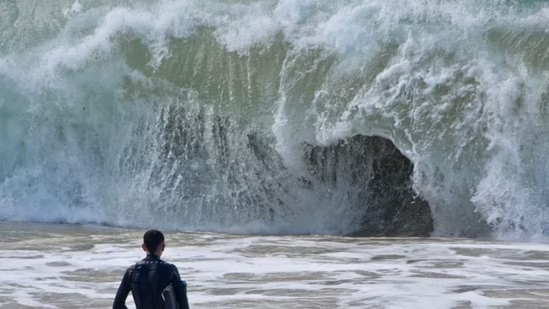Southeastern Wisconsin faces days of storms, flooding threats — here’s all to know

Northern Oregon, southern Washington, and northern California identified as the U.S. regions most at risk from a Cascadia mega-tsunami.
Southeastern Wisconsin is bracing for a turbulent stretch of weather as repeated rounds of thunderstorms sweep across the region, bringing flash flood threats, damaging winds, and power outage risks.
What started as scattered afternoon storms on Saturday quickly escalated into a series of severe weather alerts across multiple counties. Residents in both rural and urban areas were urged to remain on high alert as conditions worsened throughout the day, with warnings stacking on top of one another and a flood watch adding to the concern.
A Day of Rapidly Changing Alerts
By mid-afternoon Saturday, counties across southern and eastern Wisconsin had cycled through a string of warnings and watches. At one point, Waukesha and Jefferson counties were under a severe thunderstorm warning until 5:30 p.m., while Ozaukee, Fond du Lac, Columbia, Washington, Dodge, and Sheboygan counties faced warnings set to expire at 5 p.m.
Earlier in the day, Rock and Walworth counties were hit with warnings, with radar showing strong cells producing heavy downpours and dangerous lightning. At the same time, a broad severe thunderstorm watch was issued for Milwaukee, Racine, Kenosha, Waukesha, Jefferson, and Walworth counties — stretching until 7 p.m.
The overlapping alerts reflected the storm system’s unpredictable behavior, with one wave of storms giving way to another in rapid succession.
Why the Weather is So Unsettled
Meteorologists attribute the chaos to a quasi-stationary front draped across the state. Unlike fast-moving cold fronts that push storms out of the area, this boundary is stalling over Wisconsin. Acting like an atmospheric conveyor belt, it funnels warm, humid air into the region while repeatedly sparking new rounds of thunderstorms.
“This is one of the trickiest patterns to deal with,” explained local forecasters. “Storms fire up, move through, and then more storms form on the same track a few hours later. The ground doesn’t get a chance to dry out.”
This setup is expected to linger from Saturday through early Tuesday (Aug. 16–19), meaning southeastern Wisconsin could see storm after storm — both daytime and overnight — with the risk of flash flooding increasing each day.
The Biggest Threat: Flooding
While damaging winds and lightning are always a concern with severe storms, forecasters warn that flooding is the major threat over the next several days.
With soils already saturated from last weekend’s downpours, even moderate rainfall could overwhelm drainage systems and rivers. Several inches of rain are possible in repeated bursts, meaning the same towns could see floodwaters rising multiple times in just a few days.
Flooding dangers extend beyond rivers — low-lying neighborhoods, underpasses, and rural roads are especially vulnerable. Authorities are reminding drivers of the well-known safety rule: “Turn Around, Don’t Drown.”
Secondary Hazards: Wind, Trees, and Power Outages
Thunderstorms embedded within this system also carry the potential for strong wind gusts. Normally, trees might withstand such winds, but with ground already soggy, root systems are weaker, making it easier for large trees to topple.
That creates a dual risk — property damage from falling branches and widespread power outages if trees strike power lines. Utility crews are already on standby in anticipation of service disruptions.
Residents on Edge
For residents, the storms are both a physical danger and a mental strain. The whiplash of going from hazy sunshine to sudden lightning and downpours has created what some describe as “weather whiplash.”
“I was planning to have my daughter’s birthday party outside, but now I don’t know what to do,” said a Milwaukee mother. “The sun is out one minute and then the sky turns dark and threatening. It’s exhausting.”
Local businesses, event organizers, and sports leagues have also been forced to scramble, with many outdoor events delayed or moved indoors.
Community Images Tell the Story
Viewer-submitted storm photos reveal the dramatic nature of Saturday’s skies. One image from Mauth Lake in Fond du Lac County shows a wall of ominous clouds rolling in over calm waters — a sharp contrast that highlights the unpredictability of the weather. Other photos feature jagged lightning bolts slicing through the night sky, reinforcing the dangers faced by anyone caught outdoors.
Staying Prepared: What Officials Urge Residents to Do
With several more days of storms expected, emergency officials are urging residents to prepare now:
-
Stay Informed: Keep phones charged and enable severe weather alerts.
-
Flood Safety: Avoid driving through flooded streets and consider sandbags if you live in flood-prone areas.
-
Outdoor Plans: Prepare indoor backup options for festivals, sports, and family gatherings.
-
Emergency Kits: Stock flashlights, batteries, non-perishable food, and bottled water in case of prolonged power outages.
-
Stay Indoors During Lightning: Avoid open fields, tall trees, and bodies of water.
Looking Ahead
Forecasters warn that storms will continue through the weekend and into Tuesday, with the heaviest rainfall likely on Sunday night into Monday morning. Conditions may gradually stabilize by midweek, but until then, the risk of flash flooding and severe weather remains elevated.
For southeastern Wisconsin, this stretch of weather is more than an inconvenience — it is a test of resilience. The next few days will require patience, preparation, and caution as communities navigate the roller coaster of storms.
The danger is not just one storm, but a prolonged period of unsettled weather. Southeastern Wisconsin must brace for repeated rounds of thunderstorms, rising floodwaters, and the real possibility of widespread power issues through early next week.

